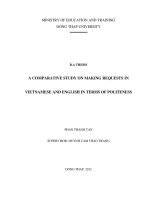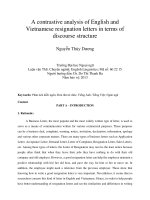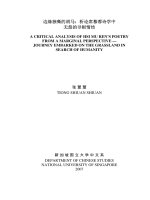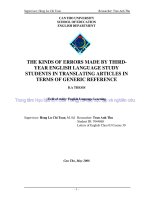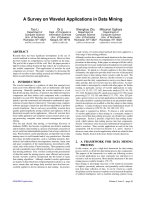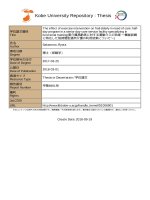A study on noun phrases in English and Vietnamese
Bạn đang xem bản rút gọn của tài liệu. Xem và tải ngay bản đầy đủ của tài liệu tại đây (412.62 KB, 7 trang )
58
||
TRƯỜNG ĐẠI HỌC THỦ ĐÔ HÀ NỘI
A STUDY ON NOUN PHRASES IN
ENGLISH AND VIETNAMESE
Bui Thi Le Minh
National Economics University
Abstract: Noun phrases (NP) might be very significant in any languages since it is
considered as a basic component to form a meaningful sentence. However, most language
can be different to each other in using noun phrases despite sharing a similar structure. In
the process of learning and teaching English, it is important and essential to have deep
understandings about the similarities and differences between English and Vietnamese NP
to minimize mistakes. This study aims to investigate English and Vietnamese noun phrases
in terms of semantic- syntactic structure. Through it, it is expected that teachers partly help
learners of English to identify the errors that they make in learning English and then avoid
making errors. The paper also suggests some teaching implications based on what have
been discussed.
Keywords: A study, English noun phrases, teaching English, Vietnamese noun phrases.
Received 3 September 2022
Revised and accepted for publication 24 October 2022
Contact author: Bùi Thị Lê Minh; Email:
1. INTRODUCTION
Words do not simply get together at random to form a meaningful unit. That is to say
they should be combined systematically and grammatically into phrases, and then into
sentences. For example, the group of words “the girls in their summer dresses” is a phrase.
In English and Vietnamese, there are three kinds of phrases whose names are defined on the
basis of the classes of the word that is the chief word or head of the phrase namely noun
phrase, verb phrase, and adjective phrase. Among those phrases, noun phrase proves to be an
interesting case that needs closer attention. The goal of this study is to understand the structure
of noun phrase in English and Vietnamese. Attention is also given to the comparison and
contrast between the structure of English noun phrase and Vietnamese noun phrase. Finally,
some implications for language teaching and language learning will be under discussion.
2. CONTENT
2.1. Theoretical background
2.1.1. Contrastive analysis
Contrastive analysis is an inductive investigative approach based on the distinctive
elements in a language (Kardaleska, 2006). Contrastive analysis is also the study and
TẠP CHÍ KHOA HỌC – SỐ 65/2022
|| 59
comparison of two languages. As Lado (1957) has stated, it is aimed to predict linguistic
difficulties experienced during the acquisition of a second language. It shows that those
difficulties that a language leaner may encounter in a new (second) language are stemmed
from the differences between the new language and their mother tongue (first language).
Their mistakes that have been made in learning a second language, therefore, could be
predicted from interference by the first language. For years, there has been a number of
researches on different language pairs, most of them have focused on English learners. A
study of errors in lexical and syntactical usage was carried out among Czech learners of
English by Dusˇkova ́ in 1969. Later in 1998, a similar investigation was conducted by
Guilford in France to explore French learners’ difficulties in various aspects including
lexical and syntactical errors. Among these studies, commonly observed syntactic error types
made by non-native English learners include subject-verb disagreement, noun-number
disagreement, and misuse of determiners.
2.1.2. Noun phrases in English in terms of semantic- syntactic structure
A noun phrase is briefly defined as a group of words with a noun or pronoun as the main
part and these phrases may consist of one word. According to Howard (1982), the noun
phrase in English is composed potentially three parts. Among these parts, the head which is
also characterised as the central part of the noun phrase is obligatory. As Howard stated, it
is minimal requirement for the occurrence of a noun phrase. In contrast, the other two parts
which are named respectively as pre-modification and p��������������������������������������������������������������������������������������������������������������������������������������������������������������������������������������������������������������������������������������������������������������������������������������������������������������������������������������������������������������������������������������������������������������������������������������������������������������������������������������������������������������������������������������������������������������������������������������������������������������������������������������������������������������������������������������������������������������������������������������������������������������������������������������������������������������������������������������������������������������������������������������������������������������������������������������������������������������������������������������������������������������������������������������������������������������������������������������������������������������������������������������������������������������������������������������������������������������������������������������������������������������������������������������������������������������������������������������������������������������������������������������������������������������������������������������������������������������������������������������������������������������������������������������������������������������������������������������������������������������������������������������������������������������������������������������������������������������������������������������������������������������������������������������������������������������������������������������������������������������������������������������������������������������������������������������������������������������������������������������������������������������������������������������������������������������������������������������������������������������������������������������������������������������������������������������������������������������������������������������������������������������������������������������������������������������������������������������������������������������������������������������������������������������������������������������������������������������������������������������������������������������������������������������������������������������������������������������������������������������������������������������������������������������������������������������������������������������������������������������������������������������������������������������������������������������������������������������������������������������������������������������������������������������������������������������������������������������������������������������������������������������������������������������������������������������������������������������������������������������������������������������������������������������������������������������������������������������������������������������������������������������������������������������������������������������������������������������������������������������������������������������������������������������������������������������������������������������������������������������������������������������������������������������������������������������������������������������������������������������������������������������������������������������������������������������������������������������������������������������������������������������������������������������������������������������������������������������������������������������������������������������������������������������������������������������������������������������������������������������������������������������������������������������������������������������������������������������������������������������������������������������������������������������������������������������������������������������������������������������������������������������������������������������������������������������������������������������������������������������������������������������������������������������������������������������������������������������������������������������������������������������������������������������������������������������������������������������������������������������������������������������������������������������������������������������������������������������������������������������������������������������������������������������������������������������������������������������������������������������������������������������������������������������������������������������������������������������������������������������������������������������������������������������������������������������������������������������������������������������������������������������������������������������������������������������������������������������������������������������������������������������������������������������������������������������������������������������������������������������������������������������������������������������������������������������������������������������������������������������������������������������������������������������������������������������������������������������������������������������������������������������������������������������������������������������������������������������������������������������������������������������������������������������������������������������������������������������������������������������������������������������������������������������������������������������������������������������������������������������������������������������������������������������������������������������������������������������������������������������������������������������������������������������������������������������������������������������������������������������������������������������������������������������������������������������������������������������������������������������������������������������������������������������������������������������������������������������������������������������������������������������������������������������������������������������������������������������������������������������������������������������������������������������������������������������������������������������������������������������������������������������������������������������������������������������������������������������������������������������������������������������������������������������������������������������������������������������������������������������������������������������������������������������������������������������������������������������������������������������������������������������������������������������������������������������������������������������������������������������������������������������������������������������������������������������������������������������������������������������������������������������������������������������������������������������������������������������������������������������������������������������������������������������������������������������������������������������������������������������������������������������������������������������������������������������������������������������������������������������������������������������������������������������������������������������������������������������������������������������������������������������������������������������������������������������������������������������������������������������������������������������������������������������������������������������������������������������������������������������������������������������������������������������������������������������������������������������������������������������������������������������������������������������������������������������������������������������������������������������������������������������������������������������������������������������������������������������������������������������������������������������������������������ypes in accordance to its function to the nucleus.
Table 7. Types of Position-1 in the end elements
Position-1
in term of word nouns
class
verbs
cardinal numeral
pronouns
nouns of time
in
term
of a principal-accesory phrase (cụm từ
structure
chính phụ)
a coordinate phrase (cụm từ đẳng lập)
Examples
hương hoa sữa
xe đạp
phịng hai mươi
điện thoại (của) tơi
Chuyến bay trước
khu vực khách V.I.P
chiếc xe đằng trước và đằng
sau
a S-V phrase (cụm từ chủ-vị)
quán kem tôi ăn
in term of way direct way (link directly to the nucleus) đơn đề nghị
of linking
khu vực thi cơng
indirect way (link to the nucleus by món q mà tôi mua
connectors)
chiếc túi mà cô ấy được tặng
Some examples of Position-2 which refers to the position of demonstrative pronouns
could be “này”, “kia”, “ấy”, “đó”, “nọ”, etc. (E.g. “Chiếc túi màu hồng đó”).
2.2. Some differences between English and Vietnamese noun phrase
TẠP CHÍ KHOA HỌC – SỐ 65/2022
|| 63
First, in English, it is important for language users to follow the occurrence of a noun
and its determiners. It means that a noun in singular form must go with a determiner. This,
therefore, seems inadequate to say “I will not buy car” in English but still possible to say
“tôi sẽ không mua xe” in Vietnamese. The diffrerence in the functions of pronouns as a head
of a noun phrase between two languages is also worhtly concerned. Pronouns usually occurs
without any kind of modification in the English language and pre-modification is virtually
impossible for pronouns. However, the combination of pre-modification and pronouns has
occured frequently in Vietnamese. For examples, saying “mấy anh mua hàng đi” is accepted
in Vietnamese, but it will be considered as grammartical errors if one says “some he go
shopping”. In addition, the head in English noun phrases must be a noun or a pronoun,
whereas the nucleus in Vietnamese can be a noun or a phrase called “ngữ danh từ”. This
“ngữ danh từ” which may include a classifier noun + a noun, a verb, an adjective is a
distinctive element in Vietnamese when comparing to English.
The appereance of identifier within a noun phrase in English and Vietnamse is also
different. While an English noun phrase mostly shows only one identifier (E.g. “a book” or
“my book”, not “a my book”), many Vietnamsese noun phrases may accept more than one
identifer in the same word (E.g. “một cuốn sách của tôi”). In this case, the correct translation
form this Vietnamese phrase into English must be “a book of mine”. Fourth, the front
elements in Vietnamese noun phrases indicate quantity while the end elements do with the
quality (E.g. “Một cô gái đẹp”). However, the pre-modification in English noun phrases may
include words of quality (Eg. “A beautiful girl”). It shows that the way front elements in two
languages occur within the phrase is different to each other. In English, it is possible to put
an adjective phrase before the head noun, but that is ungrammatical in Vietnamese (E.g. It
is impossible to say “Một đẹp cô gái” in Vietnamese). Apart from that, some other
differences between the use of noun phrases in English and Vietnamse are shown in the table
below:
Elements
English
demonstratives
before the head noun (this girl)
possesives
before the head noun (her dress,
your house)
before the head noun (the children
books)
before the head noun (the third
ordinal numbers
person)
noun modifier
Vietnamese
in the end of element + after the
nucleus (cô gái này)
always begin with ‘của’ + after
the head noun (chiếc váy của
cô ấy, ngôi nhà của bạn)
act as and end element (sách
thiếu nhi)
act as and end element (người
thứ ba)
2.3. Teaching implication
The analysis of difference between English and Vietnamese approaches to NP could be
useful for teachers of English in Vietnam when it comes to teach their students grammatical
points involving NP. Many Vietnamese learners these days seem still confused to translate
and English phrase into Vietnamese due to the differences in the word order (E.g. “một chiếc
váy mới” may be translated into “a dress new” instead of “a new dress”). Or they sometimes
forget to put determiners when translating a Vietnamese phrase into English (E.g. “cô ấy sẽ
64
||
TRƯỜNG ĐẠI HỌC THỦ ĐƠ HÀ NỘI
mua chiếc ơ” could be translated into “she will buy umbrella” instead of “she will buy an
umbrella”). And it should not be neglected to mention many other possible mistakes that can
cause students anxious to study NP are the order of adjectives, modifiers, possesives and
ordinal numbers. Teachers, in this case, should ask students to pay attention to these negative
transfers so that they can avoid making mistakes. For instance, the OSACOM (OpionionSize-Age-Colour-Origin-Material) rule could be a suggestion to help students having
troubles in putting adjectives in a correct order before a head noun to remember them easily.
3. CONCLUSION
Noun phrases in English and Vietnamese have some interesting thought-provoking
differences that are really necessary to recognize. That is not only for implication in teaching
- learning but also in translation. A careful study is very useful. This paper has mentioned
some of many interesting differences between the two languages, but it can not be a
thoughtful and informative enough writing about noun phrases.
REFERENCES
1. Diệp Quang Ban (2008), Giáo trình ngữ pháp tiếng Việt, Educational Press.
2. Doan, T. T., Nguyen, H. K., & Pham, Q. N. (2001), A concise Vietnamese grammar, Ha Noi:
World Publishers.
3. Jackson, Howard (1982), Analyzing English, Pergamon Institute of English.
4. Jonathon Guilford (1998), “English learner interlanguage: What’s wrong with it?”, Anglophonia
French Journal of English Studies, 4:73–100.
5. Kardaleska, Ljubica (2006), Contrastive Analysis and Error Analysis in Combination with
Analysis of the Semantic Level, Posted on . 24 May 2006, Retrieved from 24
May 2006 on 25 Sep 2022.
6. Libusˇe Dusˇkova ́(1969), “On sources of error in foreign language learning”, International
Review of Applied Linguistics (IRAL), 7(1):11–36.
7. Robert Lado (1957), Linguistics Across Cultures: Applied Linguistics for Language Teachers,
University of Michigan Press, Ann Arbor, MI, US.
MỘT NGHIÊN CỨU VỀ CỤM DANH TỪ TRONG
TIẾNG ANH VÀ TIẾNG VIỆT
Tóm tắt: Có thể nói cụm danh từ ln đóng một vai trị rất quan trọng đối với bất kỳ ngơn
ngữ nào bởi nó thường được xem như một thành phần cơ bản trong việc tạo nên một câu
hoàn chỉnh và có nghĩa. Tuy vậy, hầu hết các ngơn ngữ cũng sẽ xuất hiện sự khác biệt nhất
định trong việc sử dụng cụm danh từ bất kể chúng có thể mang nhiều đặc điểm tương đồng
về cấu trúc câu. Trong quá trình dạy và học tiếng Anh, việc nắm được sự giống và khác
nhau giữa cụm danh từ tiếng Anh và tiếng Việt là vô cùng cần thiết nhằm giúp giảm thiểu
việc mắc lỗi sai trong câu. Nghiên cứu này sẽ tiến hành khảo sát và so sánh về cấu trúc
ngữ nghĩa-cú pháp giữa cụm danh từ tiếng Anh và tiếng Việt, từ đó góp phần giúp người
học và người dạy có thể xác định và giảm thiểu những lỗi sai thường gặp phải trong quá
trình học tiếng Anh. Bài viết cũng đưa ra một số đề xuất ứng dụng vào công tác dạy học
tiếng Anh dựa trên những vấn đề được thảo luận.
Từ khoá: Nghiên cứu, cụm danh từ tiếng Anh, dạy tiếng Anh, cụm danh từ tiếng Việt.


